Museums and Exhibitions in New York City and Vicinity
| Home | | Museum Guide | | International | | Architecture & Design | | Theater |
GLENN LONEY'S MUSEUM NOTES
CONTENTS, October, 2001
[01] ANATOMY ART/PLASTINATION
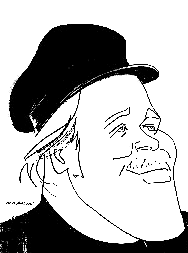
Caricature of Glenn Loney
by Sam Norkin.
[02] Jeff Koons in Bregenz Comeback
[03] Arts & Performing Arts in Bregenz/Vorarlberg
You can use your browser's "find" function to skip to articles on any of these topics instead of scrolling down. Click the "FIND" button or drop down the "EDIT" menu and choose "FIND."
For editorial and commercial uses of the Glenn Loney INFOTOGRAPHY/ArtsArchive of international photo-images, contact THE EVERETT COLLECTION, 104 West 27th Street, NYC 10010. Phone: 212-255-8610/FAX: 212-255-8612.
Copyright © 2000 Glenn Loney.
For a selection of Glenn Loney's previous columns, click here.
ANATOMY ART—
A.K.A. PLASTINATION
Your Body Will Never Decay—
It Can Always Be On Display!
[Touring in Europe] Meditation on Mummies—
Had the Pharaohs of Ancient Egypt not insisted on preserving their physical
bodies for spiritual use in the Afterlife, our knowledge of that long-vanished
culture would be much less. Incomplete certainly.
But, with the current Politically Correct practice of insisting that American Natural History Museums surrender their

|
|
| ANATOMY ART--Body Parts & Organs opened out like bureau drawers, as exhibited in Berlin. Photo: Glenn Loney/INFOTOGRAPHY/2001. | |
very ancient skulls & bones so that Native Americans can give them ritual burial in some tribal ground or other, anthropologists are in danger of losing another valuable research resource. Another Key to the Past.
Worst Scenario Yet: If Muslim Fundamentalists decide to take their cue from American Indians, the Metropolitan and the Brooklyn Museums may soon have to give back all their Mummies! Or suffer the consequences…
If you have been able to look at the stunning, shining, mysterious golden mummy-mask of King Tut, you—and countless thousands over time—may well have been dazzled both by the artistic conception and the craftsmanship of that funerary ritual ornament.
And it's almost certain, if and when you saw that celebrated mask, that you then wanted to know much more about this pharaoh who died so young—poisoned by pagan priests? And about his culture, world, and people…
Fortunately, we have Egyptologists, archeologists, anthropologists, and mythologists to thank for the interpretations they have been able to make of the fragments and shards—and the mummies & architecture—of that long-dead culture.
Catholic clerical officials have occasionally dug up a long-dead saint to see if the body has been preserved from decay, a sure sign of sainthood. Even if only bones remain, they can be wound with strings of pearls—and the gold-crowned skulls studded with jewels.
Baroque Bavaria is especially rich in such venerable religious relics. Also, of course, Italy. Visiting Jesuit Churches,
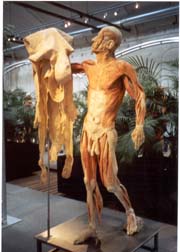
|
|
| PLASTINATED MAN WITH SHED SKIN--The Human Body as Artwork, prepared by process-inventor, Dr. Gunther von Hagens and colleagues. Photo: Glenn Loney/INFOTOGRAPHY/2001. | |
it's a bit unsettling to see a jeweled skull of a Christian Martyr grinning out at you.
Unfortunately, not much can be learned of the saints' lives and times from bones alone.
Ordinarily, however, researchers are not interested in digging up bodies interred only a century or so ago. Unless there is some forensic question about the manner of their deaths: Was Napoleon poisoned?
There is also not much to be learned from opening coffins to see how Proper Victorians were dressed for their potential presentations to either Their Lord—or to the Satanic Deity.
We already have sufficient early 19th century woodcuts and engravings of Famous Corpses Lying in State. Newspaper accounts of that time itemize their burial finery, not the overlook the hymns sung, the sermons preached, and the lists of mourners and pall-bearers.
So we really don't need to exhume them.
Unless you do not believe that General Ulysses S, Grant is actually buried in Grant's Tomb. Alongside his loving wife, Julia Dent Grant…
However, saintly people from the last century have been disinterred, but not for scientific purposes. If they merit sainthood, their remains can then be prepared for reverent repose or venerated exposure in shrines.
But without the ropes of baroque pearls wound round their extremities. Tastes and fashions—even in adorning the sanctified dead—change over time. Still, these almost pharaonic religious practices do owe something to ancient beliefs & traditions…
If you have ever read Jessica Mitford's The American Way of Death, you were probably shocked to learn that many modern corpses are prepared for Open-Coffin funerals with clothes that have no backs to them. Mourners are not about to turn the corpse over. It is usually enough to say: "She doesn't look the least bit life-like!"
Well, why should she? She is dead, after all…
Imagine Jackie Kennedy Onassis' embarrassment, on Meeting Her Maker, if she were to discover that her lovely gown had no rear panel to it!
Orthodox Jews are not embalmed and must be buried the day after death. So there would be little of interest remaining of an ordinary man for either anthropologists or forensic experts a century or so after death. The remains of Theodore Herzl might be a different matter…
If you have ever wondered, however, what might happen to your own embalmed and buried body were it to be exhumed a thousand years from now, don't worry about it. You won't be around to see it. If they haven't already nuked the cemetery…
And so much about our life & times has already been written, spoken, and recorded, that digging up some run-of-the-mill corpses won't tell them much.
In any case, for what they need to know, they can open the New York Times' Time Capsule. Designed by Santiago Calatrava, it is now sitting proudly in the parkland of the American Museum of Natural History, waiting to be opened in 3001!
But by that distant time, Manhattan might well be under 300 feet of sea-water… Divers could retrieve the Time Capsule from the "Manhattan Shelf."
If you give the matter some thought, you might be tempted to regard King Tut's Tomb as an Ancient Egyptian Time Capsule. But then, they left so many of them strewn about the Nile Valley.
Prof. Dr. Gunther von Hagens Will Preserve Your Body! There is now an amazing way to preserve your earthly body for the forseeable future—and then some. This method is called PLASTINATION. It has been developed by Dr. Gunther von Hagens, notably when he was a professor at Heidelberg University.
Remaining in historic Heidelberg, he now has his own scientific institution for further research in human tissue-preservtion and preparing specimens for educational purposes. And even for artistic/aesthetic exhibitions.
It has always been very difficult for medical resarchers to obtain bodies for dissection. Religious beliefs and civil laws have largely forbidden this practice over the centuries.
So scientists such as Leonardo da Vinci and later medical researchers had to find their cadavers where—and as—they could. Grave Robbers were not only looking for rings, jewelry, and watches on the corpses they dug up at midnight. The corpse itself might fetch a good price at the medical school…
Even today, there are not enough cadavers for all the new medical students to dissect and learn about the complexities of the human body. Shortly after death—even with cooling and partial embalming—the organs begin to deteriorate.
So Dr. Von Hagens began experimenting with ways to preserve donated bodies for such teaching and research.
In perfecting Plastination, he has also been able to preserve permanently fully dissected bodies—with muscles and organs standing out from the skeletal structure, to show how all the elements inter-relate.
And he has also been able to slice preserved bodies into cross-sections, vertically or horizontally, to demonstrate in depth the shape. position, function, and appearance of various organs.
As each body differs in some respects from others, both students and doctors find it valuable to see how such differences may effect surgical operations and treatments.
While accident-victims and the dying can now leave body-parts for use in other living bodies, Plastination permits the
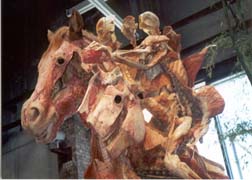
|
|
| HORSE & RIDER--Both Animals and Humans can be preserved and dissected with the Plastination Process. Photo: Glenn Loney/INFOTOGRAPHY/2001. | |
use of the entire body after death for scientific and humanitarian endeavors.
Dr. Von Hagens has prepared a number of very impressive mountings of human-bodies, body-parts, and body-systems for demonstration purposes. Not least to encourage people to consider donating their bodies for this new form of Physical Imortality.
He and his co-workers have, however, been so ingenious in preparing their specimens that they began to view them as a new form of artwork. So, from showing them in medical lecture-halls and research labs, it was only a small step to organizing a public exhibition.
This is called ANATOMY ART, and it was on view this past summer in Berlin. It filled the vast spaces of the Alte Post Bahnhof, accomodating thousands of entranced visitors. It has already been shown in Japan and in other leading German cities.
Apparently, there are no current plans to bring it to the United States. It may seem just too ghoulish for many American museums and galleries to program. Even on the videotape for the show, the English voice-over suggests that once you have "overcome your initial revulsion," the figures can seem quite beautiful.
Yes, there is a video, poster, catalogue, tote-bag, and T-shirts! These currently fashionable Museum Show Accessories suggest an exhibition orientation more commercial than scientific.
Nonetheless, Dr. Von Hagens' institute needs both ongoing funding and more bodies. It was clear to me—who did in fact have some difficulty in "overcoming my initial revulsion"—that most of the hordes of exhibition visitors were fascinated with what they saw there. And some indicated they'd like to have their bodies preserved.
Any three-pack-a-day smoker should quit cold after looking at the plastinated lungs of a long-time smoker, compared with healthy lungs. Smokers' lungs are gray or black!
Once plastinated, they will stay that way for years—long after their previous owner has died of lung cancer. Yes, you can also study the development of tumors and embolisms in Dr. Von Hagens' specimens.
You can even see the body of a young pregnant woman, her stomach cut open to reveal the almost fully-grown fetus in her abdomen. Almost too much for me, though I had a difficult time photographing some displays owing to the constant crowds on all sides of the figures.
A man stands tall, holding his own plastinated skin over one hand, like a jump-suit! Two muscular men—their muscle-systems clearly exposed—fight a duel with fencing-foils.
A male figure seems to open a drawer in his mid-section, inviting inspection of his stomach. But all over his preserved body, square and rectangular sections are pulled out, with various organs exposed.
The idea of strangers going through your bureau-drawers after you are dead is unsettling enough. But the idea of people looking at your own body like a chest of drawers—open for inspection—was too much for me.
One colorful specimen is the entire blood-red circulatory system in clear plastic.
The big showpiece of Anatomy Art, however, is a dissected horse & rider, leaping up in the air. It could be a heart-stopping horror in a Tim Burton film.
Because Gunther von Hagens is always photographed wearing a wide-brimmed black fedora—rather like the late avant-garde artist Joseph Beuys, from whom he may well have borrowed "The Look"—it is clear that he does think of himself as an Artist as well as a Scientist.
In a handsome booklet—INFORMATION BROCHURE ON DONATING YOUR BODY FOR PLASTINATION—Dr. Von Hagens explains the preservation process. Body fats and water are replaced with "reaction plastics," such as silicon, rubber, or epoxy resin.
Even the tiniest cell-structure is accurately preserved. The effect is quite remarkable. But let the good doctor describe it himself:
"By placing the specimen in a tank of cold solvent (e. g. in acetone), first the water in the tissue and then the fat in the tissue is gradually replaced by the solvent at room temperature. The specimen, from which the fat and the water have now been removed, is then placed in the plastic solution. The solvent is then brought to the boil in a vaccum and continuously sucked away. This causes a volume deficit in the specimen which allows the plastic gradually to permeate every cell. This 'forced impregnation' is a very slow process which takes days and weeks, thus ensuring that all the tissue structures are retained. The plastic is then hardened, using gas, light, or heat, depending on which plastic was used in the first place."
The Renaissance researcher, Andreas Vesalius, performed public dissections for interested spectators. Dr. Von Hagens has included in his exhibtion a reproduction of a very old engraving showing Vesalius at work in medical-school amphitheatre.
Gunther Von Hagens regards this as the precursor of what he calls "Anatomical Theatre." So it was only a small stretch of the imagination for him to call his own plastinated figures "Anatomy Art."
In the centuries after Vesalius and Da Vinci, both medical schools and museums maintained rooms with preserved animals, fetuses, malformed babies, two-headed calves, diseased organs, human brains, and other pickled body-parts.
When Austrian composer Franz Josef Haydn died, his head was severed from his body. So that the brain of this musical genius could be more closely studied and admired by Phrenologists.
Only in the latter part of the 20th century was the head reunited with the corpse. The Russians had taken it from Vienna after World War II, while the body was preserved in state in a great sarcophagus in Eisenstadt. This is the site of the magnificent Eszterhazy Palace—where Kapellmeister Haydn wore the Prince's livery like any other servant of the Greatest Magnate in Austro-Hungary.
In 19th century America, the great showman, P. T. Barnum showed preserved freaks in his American Museum. So there is a long tradition of this kind of exposure of dead bodies.
Dr. Von Hagens plans to create a special museum for his artfully arranged figures. You could become one of them!
The Body Donation Office in Heidelberg can be phoned: 011-49-6221-3311-50.
Dr. Von Hagens is planning annual informational meetings for potential donors. He proposes to show specimens, provide more detailed information about plastination developments, and encourage an exchange of views.
This would surely be in Heidelberg, where his HQ is right in the middle of this romantic old Renaissance city—with its great ruined castle. In fact, he's to be found at Rathaus-Strasse 81!
[From 1956-59, Heidelberg was also my HQ, when I taught for the University of Maryland Overseas, servicing the American Occupation Forces. We held our graduations in Heidelberg University's Neue Aula, or New Hall. Actually, the correct name of this august institution is Ruprecht Carolus University—and the tuition is minimal, compared even with American Land-Grant public universities. But you have to be able to function in German…]
If you would like to know where and when Von Hagens' amazing exhibition can be seen—or simply to learn more about the process and its uses—phone: 011-49-6221-3311-0. One digit less than the number for donating your human remains.
With any luck, your Immortal Soul will have drifted on to a Better Place…
Kunsthaus Bregenz—
JEFF KOONS Am Bodensee!
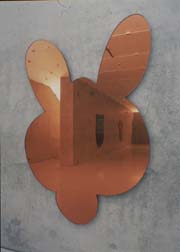
|
|
| PLAYBOY BUNNY EARS--Jeff Koons' mirror-artwork reflects his paintings in Kunsthaus Bregenz. Photo: ©KUB/Markus Tretter/2001. | |
What is it about some American artists? They may have enjoyed some brief notice and celebrity in the United States. But when their Warholian fifteen-minutes are up, new talents displace them at the Whitney and MoMA.
They become virtually forgotten, certainly neglected. Especially so with talents in the performing arts, like Peter Sellars and Robert Wilson.
And yet they continue, in Europe, to be regarded as major modern artists: commissioned, collected, coddled, and admired.
Can this be yet another example of the old saying: A Prophet is always without honor in his own country."
Recently, American Jeff Koons has been honored with a major show filling the Kunsthaus in Bregenz. He is still Big News in Central Europe.
Of course, there were some tentative signs of a New York comeback in summer 2000. His giant PUPPY floral sculpture dominated Rockefeller Center to the delight of kiddies and tourists.
But this amusing conception had already been exposed in Europe over a decade before. In front of the Main Rail Station in Hannover, I believe it was.
[This past summer, Louise Bourgeois's huge metal Spider was installed in Rockefeller Center. It was previously on view in the great Turbine Hall of the New Tate in London.]
Back to Bregenz! It is sited at the southern end of Lake Constance, or the Bodensee. This immense body of water—through which Rhine River waters flow from their alpine source—is bordered by France, Switzerland, Germany, and Austria.
Bregenz is the western-most city in Austria. And it is most famous for its summer Bregenz Festival, with spectacular productions of operas and musicals on its immense lake-stage.
Not to overlook major stagings of unjustly forgotten or neglected operas in the Post-Modernist Festspielhaus. Carlisle Floyd's opera version of John Steinbeck's Of Mice and Men was a big hit this past summer.
Bregenz and its surrounding area has long been both a summer and winter vacation-resort. It even boasts some small palaces of princely holiday-makers.
It has an historical/architectural Split-Personality, as well. The Upper City is a Medieval Gem. The lower city has a major international highway running right through it.
A fast driver can get from the German border through Bregenz to the Swiss border in a matter of miles and perhaps half an hour. If the gendarmes aren't on his tail…
But the sight of a huge stage-setting looming out of the lake has slowed down—and often stopped—many a car. And
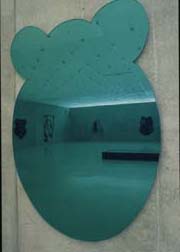
|
|
| ARE THESE BEAR'S EARS?--More of Jeff Koons' amusing mirror-shapes on display on the Bodensee. Photo: ©KUB/Markus Tretter/2001. | |
it has built the fame and fortune of the Festival.
But—with as many as four or five potential performance-evenings on various stages—Bregenz has been developing museums, galleries, historic preservation, special arts programs, and other cultural attractions for tourists. And, of course, for the local citizens, many of whom are also working in the festival.
In addition to impressive art-exhibitions in Palais Thurn und Taxis, there are some cutting-edge galleries, an excellent historical museum. And now, the elegant and astonishing Kunsthaus! Or Art House, if German wasn't your foreign-language requirement.
It is composed of huge thick slabs of tempered translucent—not transparent—glass, supported on a strong steel framework. So its handsome shows of contemporary art always profit from the ambient glow of natural daylight. Of course, there's state-of-the-art artificial lighting as well.
Major young European artists are featured. But this past summer, the spotlight was on Jeff Koons, a long way off from his ill-starred, ill-conceived brief marriage to Italian porn-star Ciccolina.
Conception—whether for good or ill—is Koons' claim to artistic achievement. He gets the visual ideas and then engages real craftsmen to make them realities. In Bregenz, my favorite Koonses were the colored mirrors shaped like bunnies and whatever.
They had the added attraction of reflecting some of Koons' cartoonish but colorful canvases on opposing walls. American advertisting—as has American product-design—obviously offers him ample scope for Daliesque Pop-Art visual collages of trendy images.
Among the best: Cheeky and Saint Benedict, both devised and executed in 2000 AD.
Not that European curators or critics are in any sense "taken-in" by Koons' self-promotion and vaccum-cleaners in plastic showcases. A Vienna critic characterised him as "oscillating between Kitsch and Kunst."
An amusing bio-appraisal in a major art-journal was titled: I Sell, Therefore I Am." Recasting René Descartes' famed pensée: "I think, therefore I am." [Cogito ergo sum.]
Arts & Performing Arts in Bregenz & Vorarlberg:
Bregenz is the capital of Austria's Land Vorarlberg—which is like an American state or an English province. It is a city sandwiched between an immense lake and impressive alps!Its developing Arts Scene—including art in the schools—is annually chronicled in a handsome volume, Vorarlberger Kulturbericht.
This interesting survey also includes museums, theatres, landmarks, and arts programs in nearby towns and cities such as Hohenems. This ancient center—with a proud medieval castle—features an annual Schubertiade. And a Jewish Museum, as well!
The extent and variety of cultural activities is amazing. As well as the charming—to an Auslander—names of the arts-loving communities: Dornbirn, Feldkirch, Rankweil, Bludenz, Lauterach, Lochau, Lustenau, Götzis, Montafon, Schwarzach, and Egg—famous for the great Austrian woman painter, Angelika Kaufmann.
Dr. Werner Grabher—Chief of the Vorarlberg state-government's Culture Office—pointed out all these riches to me. Some of them I already knew fairly well.
But my visit to the Festival was coming to an end—and I had spent most of it in the Opera Workshop, seeing performances, and writing reviews. So I will have to check out some of these very intriguing sites and ensembles next summer!
[Loney]
Copyright © Glenn Loney 2000. No re-publication or broadcast use without proper credit of authorship. Suggested credit line: "Glenn Loney, Curator's Choice." Reproduction rights please contact: jslaff@nymuseums.com.